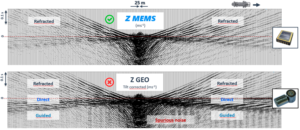25th January 2022
Registration
PESGB members can register free of charge via the membership platform
If you are interested in becoming a member of PESGB please visit: https://www.ges-gb.org.uk/membership/
Event Information
Speaker: Nicolas Tellier – Chief Geophysicist, Sercel
Topic: MEMS sensors for true amplitude, phase, verticality and vector fidelity sensing
Abstract
The latest, third generation of MEMS sensors specified for seismic have overcome the limitations of the previous generations: their noise floor, cost and power consumption are now in line with an excellent ADC connected to a high-sensitivity, low-frequency geophone. MEMS technology exhibits in addition the lowest distortion in the industry, absence of spurious frequency and insensitivity to electro-magnetic contamination.
MEMS record true amplitude and phase from DC to 400 Hz, owing to the ultra-low tolerances associated with their manufacturing, stability over temperature variations and ageing. It makes a difference with other sensing technologies, e.g. geophones that exhibit a significant jitter at low frequencies, up to 4 dB in amplitude and 15° in phase when their specifications are factually observed. The capability of MEMS to sense static acceleration signal such as the gravity brings additional benefits when used in 3C configuration, tilt detection and factory calibration making it possible to record true vertically and horizontally polarized seismic data.

In a shallow water, long offset context, reoriented vertical (Z) data is expected free of direct and guided wave. This is the case for the 3C MEMS CRG (top) LMO’d to account for water velocity, but not for its 3C geophone counterpart (bottom) that is in addition contaminated by high-frequency spurious noise.
Owing to these numerous advantages that will be supported by field data, the third generation of MEMS sensors thus appear as excellent candidate for single sensor and OBN applications, and for all applications requiring high-fidelity datasets.

